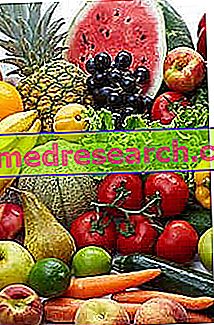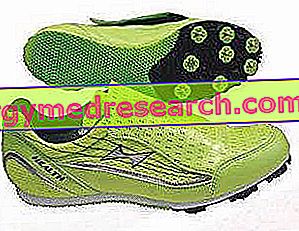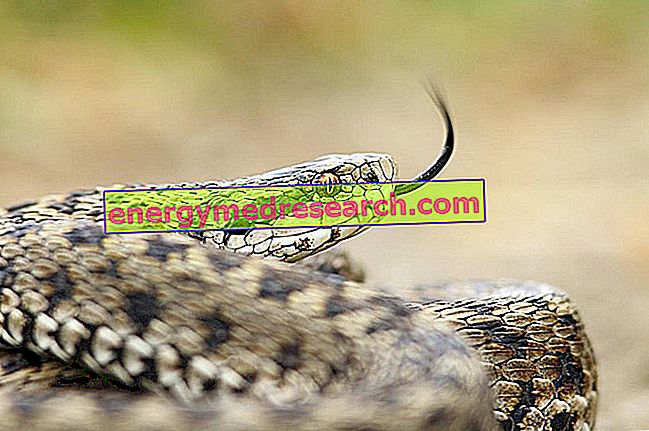Care of the Dottr Simone Marata
The anti-inflammatory diet
Fruit and vegetable consumption has been linked to the reduction of morbidity and mortality due to chronic degenerative diseases. It is not yet clear how the constituents of the diet are responsible for this association, but it seems that antioxidants play a greater role in carrying out this protective effect [1].

[1] Pellegrini N., Serafini M, Colombi B., et al. "Total Antioxidant Capacity of Plant Foods, Beverages and Oils Consumed in Italy Assessed by Three Different In Vitro Assays". J Nutr. 2003, 133: 2812-2819.
[2] La Vecchia, C., Altieri, A. & Tavani, A. (2001) "Vegetables, fruit, antioxidants and cancer: a review of Italian studies". Eur. J. Nutr. 40: 261-267.
[3] Pellegrini N., Serafini M, Colombi B., et al. "Total Antioxidant Capacity of Plant Foods, Beverages and Oils Consumed in Italy Assessed by Three Different In Vitro Assays". J Nutr. 2003, 133: 2812-2819.
[4] Brighenti F, Valtuena S, Pellegrini N, et al. "Total antioxidant capacity of the diet is inversely and independently related to plasma. C-reactive protein in adult Italian subjects." Br J Nutr 2005; 93: 619 -25.
The inflammation
Inflammation or inflammation means the set of changes that occur in a district of the organism affected by damage of an intensity that does not affect the vitality of all cells in that district. This damage can be caused by physical agents (trauma, heat, etc.), by chemical agents (toxic compounds, acids, etc.) and by biological agents (bacteria, viruses, etc.). The damage response, the inflammation, it is given by the cells that have survived the action of it and therefore it is predominantly a local reaction that medical terminology indicates by adding the suffix -ite to the name of the organ concerned (for example the terms tendinitis, hepatitis indicate inflammation, respectively to a tendon and to the liver). It has been said predominantly local reaction and not exclusively local in that different molecules that are synthesized and released by the cells that participate in the phenomenon of inflammation pass into the blood and act on distant organs, particularly on the liver, stimulating liver cells to release other substances that are responsible for the acute phase response to inflammation. The onset of fever and leukocytosis (increase in the number of leukocytes circulating in the blood) represent other systemic manifestations of inflammation. In itself, inflammation is a useful process for the organism, as it allows to neutralize (if present) the agent that caused the damage, and to reinstate the condition of pre-existing normality to the damaging event. In the case of a muscle injury, for example, the consequent inflammatory process will be necessary above all to activate a process to share the damage itself (in this case the agent that caused the damage will be a physical agent, eg a trauma, and therefore there will be no need to eliminate the agent that caused the damage, as it happens in other cases. The most known symptoms of inflammation are the increase in the local temperature, the swelling, the redness, the soreness and functional impairment. The phenomena that cause these symptoms are mainly due to events involving the microcirculation of the blood. A very rapid initial vasoconstriction will be followed by the relaxation of the smooth muscular fibrocellules present on the walls of the terminal arterioles, with consequent vasodilation and a greater flow of blood in the area of the trauma (hence the appearance of the increase in local temperature and redness). Subsequently, the greater inflow of blood "stagnates" in the area of the trauma, thus increasing the viscosity of the blood (due to the aggregation of the red blood cells and to the exit towards the intracellular junctions of the "liquid" part of the blood); the outflow of the leukocytes from the blood to the extravascular compartment will also begin, where they are recalled by particular cytokines. Thus the exudate is formed, the cause of the swelling in the area of the trauma, consisting of a liquid part and a part of cells suspended in it. Finally, the process of restarting cell damage will begin.
The set of processes described above is mediated by numerous molecules that trigger, maintain and even limit changes in the microcirculation. These molecules are called chemical mediators of phlogosis, and may have different origins and different destinies. They are histamine, serotonin, arachidonic acid metabolites (prostaglandins, leukotrienes and thromboxanes), lysosomal enzymes, cytokines (type 1 and type 2), nitric oxide, the quinine system and the complement system. Instead, the cells involved in inflammatory processes consist of mast cells, basophilic granulocytes, neutrophils and eosinophils, monocytes / macrophages, natural killer cells, platelets, lymphocytes, plasma cells, endotheliocytes and fibroblasts. Inflammation is therefore a temporary process of regeneration and restoration of the normal condition following damage; however, if the agents causing the damage persist or there is a preferential production of type 1 cytokines, it may become chronic. In this case we first witness a progressive reduction of the processes described above at the expense of the microcirculation - as occurs in healing -, while at the same time the cellular infiltrate is progressively made up of macrophages and lymphocytes that frequently arrange themselves around the vascular wall like a sleeve which induces its compression. As a result, a state of tissue suffering takes over, determined both by the presence of the infiltrate and by the reduction in blood supply caused by vascular compromise. Subsequently the fibroblasts can be stimulated to proliferation with the consequence that many chronic phlogoses culminate with an excessive formation of connective tissue which constitutes the so-called fibrosis or sclerosis. For example, this is the case of cellulite, an aesthetic blemish that affects many women, caused by the increase in the volume of fat cells in certain parts of the body (thighs, buttocks, etc.) with lack of drainage of liquids and processes of local inflammation which in more advanced stages, they can lead to fibrosis and sclerosis with the formation of micronodules which give the skin the classic "orange peel" appearance.
Oxidative Stress
Free Radicals are molecules or fragments of molecules characterized by the presence of one or more unpaired and independent existence electrons; they have a strong oxidizing or reducing power and are very unstable, as such they give rise to a series of oxido-reductive effects with a clear prevalence of oxidative ones. The formation of free radicals is a process that occurs in many cellular biochemical reactions - for example, they can form during the respiratory chain - but also due to the physical action exerted by the radiant energy on our body; among the most known free radicals deserve mention the superoxide anion and the hydrogen peroxide.
Oxidative stress is linked to an imbalance between the production of reactive species (free radicals) and antioxidant defenses. In practice, oxidative stress can be defined as a disturbance of the relationship between pro-oxidant molecules and antioxidant molecules, capable of causing potential cellular damage. Oxidative stress is indeed involved in the etiology of many chronic-degenerative disorders, such as cardiovascular diseases, diabetes, cancer and neurodegenerative processes (eg Alzheimer [1]). In intense physical activity oxidative stress is a factor that can affect athletic performance. Intense physical exercise notoriously causes an increase in biochemical reactions linked to the need to produce the energy necessary to perform muscular work and this also causes an increase in the production of oxygen free radicals, which can contribute to direct damage. to muscle and to the appearance of post-workout muscle soreness symptoms.
[1] FrlichI, Riederer P (1995) "Free radical mechanisms in dementia of Alzheimer's type and the potential forantioxidative treatment." Drug Res 45: 443-449.
Composition of the anti-inflammatory diet
We said at the beginning of this short article that the amount of a single antioxidant (eg vitamin E or tocopherol, vitamin C or ascorbic acid etc.) contained in a food does not necessarily reflect its total antioxidant capacity (total antioxidant TAC capacity) [1], but that this depends instead on the synergy and on the oxido-reductive interactions between the different molecules present in the food [2]. Going now in detail, we must better clarify and overcome also the concept of total antioxidant capacity, in how in vivo the antioxidant compounds act with different mechanisms, therefore a single method cannot be used to evaluate the TAC of a food [3]. The three tools proposed by the study just mentioned are: Trolox equivalent antioxidant capacity (TEAC) [4], total radical-trapping antioxidant parameter (TRAP) [5] and ferric reducing-antioxidant power (FRAP) [6]. This Italian study [7] then worked to determine these three parameters for the main plant foods, for fruits, for drinks and for oils consumed in Italy, thus creating a database from which it is possible to draw for the drafting of the anti-inflammatory diet. Other studies at world level have also dealt with these determinations, and among the many it is worth mentioning the study entitled "The total antioxidant content of more than 3100 fodds, beverages, spices, herbs and supplements used worlwide" appeared in the Nutrition Journal in 2010 [8]. In drafting the anti-inflammatory diet it must be taken into account that it will not be a single food to be effective, as it will never be a food supplement - but rather it will be the synergy between foods that provide different antioxidant molecules - to counteract the inflammatory processes that occur, for example, after a muscle injury, or to counteract the action of free radicals. Therefore, an example of an anti-inflammatory diet plan will have to make daily:
- 5 portions of fruit and vegetables with high antioxidant power (eg wild berries, red plums, spinach, broccoli etc.);
- 2 servings of hot drinks like coffee, tea and chocolate;
- 1 serving of 200 ml of a drink like orange juice, mix of juices (orange, carrot, lemon) etc .;
- 1-2 glasses of red wine;
- Extra virgin olive oil.
A diet so composed has been shown to be able to reduce a systemic markers of inflammation such as Reactive Protein C [9].
[1] La Vecchia, C., Altieri, A. & Tavani, A. (2001) "Vegetables, fruit, antioxidants and cancer: a review of Italian studies." Eur. J. Nutr. 40: 261-267.
[2] Pellegrini N., Serafini M, Colombi B., et al. "Total Antioxidant Capacity of Plant Foods, Beverages and Oils Consumed in Italy Assessed by Three Different In Vitro Assays." J Nutr. 2003, 133: 2812-2819.
[3] Pellegrini N., Serafini M, Colombi B., et al. "Total Antioxidant Capacity of Plant Foods, Beverages and Oils Consumed in Italy Assessed by Three Different In Vitro Assays." J Nutr. 2003, 133: 2812-2819.
[4] Pellegrini, N., Re, R., Yang, M. & Rice-Evans, CA (1999) "Screening of dietary carotenoids and carotenoid-rich fruit extracts for antioxidant activities applying the 2, 2-azobis (3- ethylenebenzothiazoline-6-sulfonic) acid radical cation decolorization assay. " Methods Enzymol. 299: 379-389.
[5] 13. Ghiselli, A., Serafini, M., Maiani, G., Azzini, E. & Ferro-Luzzi, A. (1995) "A fluorescence-based method for measuring total plasma antioxidant capability". Free Radic. Biol. Med. 18: 29-36.
[6] Benzie, IFF & Strain, JJ (1999) "Ferric reducing antioxidant power assay: direct measure of total antioxidant activity of biological fluids and modified version for simultaneous measurement of total antioxidant power and ascorbic acid concentration." Methods Enzymol. 299: 15-27.
[7] Pellegrini N., Serafini M, Colombi B., et al. "Total Antioxidant Capacity of Plant Foods, Beverages and Oils Consumed in Italy Assessed by Three Different In Vitro Assays." J Nutr. 2003, 133: 2812-2819.
[8] Carlsen et al. "The total antioxidant content more than 3100 fodds, beverages, spices, herbs and supplements used worldwide". J Nutr 2010, 9: 3.
[9] Valtuena S, Pellegrini N, Franzini L, et al. "Food selection based on total antioxidant capacity can modify antioxidant intake, systemic inflammation, and liver function without altering markers of oxidative stress". Am J Clin Nutr 2008; 87: 1290-7.
Anti-inflammatory diet in sport
During muscle exercise, high levels of ROS (reactive oxygen species) are produced, the so-called oxygen free radicals, which are associated with increased muscle damage with loss of muscle function. For this reason, over the years much emphasis has been given to the possibility of supporting the antioxidant defense system with exogenous substances, in order to prevent muscle injuries and improve athletic performance. The articles published on this topic are many, and the constant result is that antioxidant supplementation reduces the oxidative stress induced by physical exercise. Conversely, there is a growing body of evidence indicating harmful effects of antioxidant supplementation compared to the health and performance benefits of exercise. A recent review [1] on the topic concluded that "more research is needed to produce evidence-based guidelines regarding the use of antioxidant supplements during exercise. An adequate intake of vitamins is recommended. minerals through a varied and balanced diet, as this remains the best method to maintain the optimal state of antioxidants in subjects who practice sports. "
[1] Peterlenj TT, Coombes JS "Antioxidant supplementation during exercise training: beneficial or detrimental?" Sports Med. 2011; 41 (12): 1043-69.



